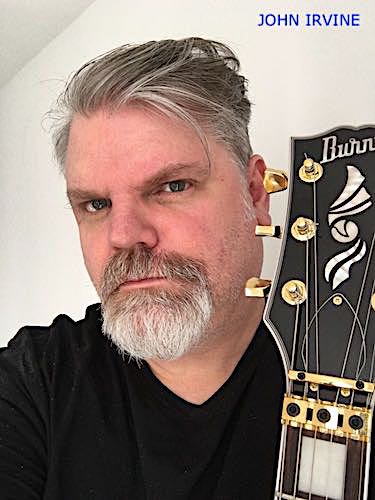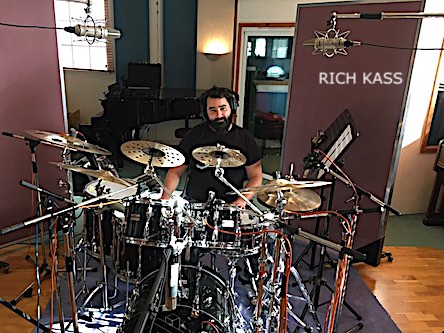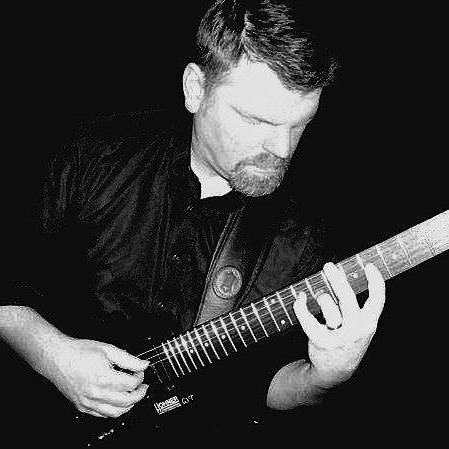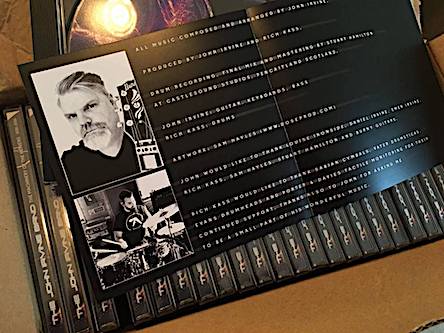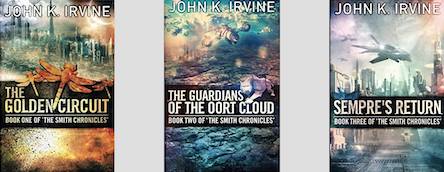 
|
||||
|
|
THE JOHN IRVINE BAND |
|||
|
mwe3.com presents a new interview with
John Irvine: The material for The Machinery Of The Heavens was already written and recorded by the fall of 2019. However, Rich Kass was on tour with HLK & Evelyn Glennie at the time and we couldn’t get the diaries to match up to record the drums. We decided to wait until the spring of 2020 – the end of March – unfortunately this turned out to be right at the start of the lockdown here in Scotland so we had to cancel the dates. The next time we could do it was in September, when restrictions were lowered. The 2nd wave was well on its way but fortunately the drums were in the can by then. So, you can see that there was almost a year in between me finishing writing The Machinery Of The Heavens and it finally being completed. As a result of our two lockdowns I found myself with plenty time to write music for the next projects. I was furloughed, my kids - who are in their late teens - didn’t need to do any home-schooling, so things were quiet. I have managed to get three albums worth of material completed, and while I am delighted by this - and it has put me way ahead of schedule - the need to put the foot down creatively has somewhat disappeared. It will come back though… fingers crossed! mwe3: You say you feel that The Machinery Of The Heavens is your best album yet. You mentioned it had more of a prog feeling to it. Is that one reason you say it’s your best album yet? You have some of your best music on it, I agree. John Irvine: When I started The John Irvine Band back in 2011, I had wanted to carry on the torch of the great fusioneers from the 1970s and ‘80s. Mainly the ones that had a more expansive approach to composition, bands like the Pat Metheny Group, Weather Report, Brand X, Oregon, Dixie Dregs etc. I just felt that there just wasn’t enough of this sort of music around; that there was only a finite amount of music that combined jazz and rock in a way that was ‘progressive’ compositionally. I wanted to hear pieces, short and long form, that took you on a journey like a ‘70s YES album does, if that makes sense. If we think about Close To The Edge, Topographic Oceans, Relayer … what a fantastic trip they gave us there for a while. On The Machinery Of The Heavens I have just let that side of things take me where it wants to, without worrying whether if things were ‘jazzy’ enough. Another change is that a lot of this album was composed on keyboards rather than on guitar, this has resulted in a slightly more complex harmonic world as I tend to play different chords on the synthesizer than I would normally play on the guitar. In the end, I feel that The Machinery Of The Heavens is the most accurate representation of that initial vision that I have produced so far. Though I must say that I think the next album, Esoteric Dimensions, will eclipse this one. mwe3: The first track is “Dark Skies” certainly sets a more progressive tone. How did you layer that track? It certainly catches the listener’s ear!
mwe3: Tell us more about working with drummer Rich Kass and how you worked with Rich on the production of the new album. John Irvine: Rich is one of the most highly regarded musicians in Scotland and I’m very lucky to have him involved in my music making. He is a true virtuoso, but without the ego, and with a very thoughtful musical personality. It’s not often that you meet musicians who are trying to push boundaries, most are very content to stay within their own limited view of what music means to them, but Rich is the exception. He is constantly striving to get better at his craft, and seeks influence from a huge variety of musical idioms in order to make that happen. What I noticed particularly on this album is how he manages to make sense of changes in the musical texture; he’s excellent at introducing one section of music to the next. It’s also a luxury to have him in the studio to help produce, as he comes up with lots of ideas and I don’t have the critical faculty to judge the micro level differences between one drum take and the next. I’m not a drummer so can’t focus in on a drum part the way he can. He is a jazz drummer essentially and this brings an element to the soundworld that I don’t have as I’m more classically trained with a firm prog-rock background. I don’t play be-bop, he can. I don’t swing, he can. You know, these differences make for an interesting combination.
John Irvine: The title for “…And How Much For The Robot?” was inspired by the scene in The Force Awakens when Rey is cashing in her scrap for food and Unkar Plutt, the Jakku junk boss, wants to buy her droid BB-8. I mis-remembered what he said as “…And How Much For The Robot.” What he actually says is: “What about the droid… I’ll pay for him.” Not as catchy. mwe3: Tell us about your guitar set-up on The Machinery Of The Heavens and did you use amps in your studio or was the guitars recorded directly in. Did you change or alter your guitar sound from your 2019 album Metaphysical Attractions? John Irvine: I don’t like gear. It always breaks and provides way too many headaches, so I keep my setup really small. My guitar signal path goes: Guitar – BOSS TU-3 tuner – DONNER Harmonic Square Pitch Shifter – YAMAHA DG Stomp (Pre-Amp w/ Effects) - FOCUSRITE Scarlett 2i2 – I spend a lot of time EQ’ing sounds in Digital Performer but I know that the finished result won’t be achieved until I go into the studio and Stuart Hamilton will add valve compression and fine tune everything. I’m looking for something that I think sounds professional enough to release BEFORE going into Castlesound Studios ... then I know that it’s going to sound great once Stuart gets hold of it. And, yes, I have used amps in the past for recording but TBH I’ve never really noticed much enough of a difference between them and my direct sound. Also, my music is not that heavy, so valves are not really a prerequisite. I say that, but a lot of newer metal bands go direct, it’s bands like AC/DC et al that you really couldn’t imagine using anything else but a Marshall stack. So, no, my guitar sound and setup has not changed much at all. mwe3: Speaking of prog “Dangerous Notes” mixes fusion with a neo-Canterbury prog sound ala Hatfield And The North if anyone is old enough to remember those days! What is that cool keyboard sound you’re featuring on that track?
mwe3: What keys open “Take It From The Edge”? Do you think the track has some Scottish kind of sounds in places? That flute like bridge is very cool! What guitars are you using on that one? John Irvine: The keys on “Take It From The Edge”, which is a jazz term for ‘start at the beginning’, is a DP patch called “Putnam Pad” which I presume is a reference to the films of David Putnam, who made Chariots Of Fire and The Killing Fields both soundtracks associated with either Vangelis or Mike Oldfield. But if any of this track sounds Scottish in places then it is very much an unconsciousness influence as I’m not keen on traditional folk music. The guitar on that one is a Burny RLC85s. The Les Paul copy with a Sustainer pickup in the neck. I don’t have it any more, it was a really heavy guitar and not good for having around your neck for long periods of recording. At the moment I’m using a white Jackson Dinky Pro. Really lightweight. In fact, it is the only guitar that was involved in recording the lockdown album sessions. So will be the only electric guitar on the next three JIB releases! mwe3: “(Across) Lunar Fields” is one of your classics. You get a great sound. What guitar are you using on that track? How many instruments on that song? John Irvine: I was really happy with the way “(Across) Lunar Fields” turned out, thanks. As I recall, the lead part is played on the Burny. And, again, the tracks number between 10-15, with drums recorded in the studio. However, the synth textures I chose are all quite dense, so that gives the impression of a much bigger sound. There is lots of reverb on this track too! I must say, I do like the structure of “(Across) Lunar Fields”. It took a while to get it right but the way the melody keeps getting added to is very nice. I think the moment at 4:00 is one of my best bits of writing, very Wind & Wuthering! The last two minutes of the track features something I like to do which is to bring back a truncated version of the main melody line over a different harmony. If you analyzed my music you’d see that happening a lot. Then, near the end, the old trick of bringing in something entirely new: those Holdsworthian chords on keys that take us to the end where we have a recap of the material that ushered in the middle section. So, all in all, a good example of my style and a track that shows the ambitions of the JIB project. mwe3: How was Stuart Hamilton involved with the final mix and mastering. How was that process completed?
mwe3: Tell us about track 7 “Blast From The Past”, do you like that ultra-melodic blasting sound. How does that track rate on your sonic scale and what can you tell us about the song title? John Irvine: “Blast From The Past” almost didn’t make it onto the album, I thought it was too poppy at first. Though I must say that some parts remind me of Wishbone Ash, actually. Strange what you think is in there! Indeed, Rich Kass said it sounded like Zappa in places! The title was chosen to reflect the fact that I thought it sounded quite 1980s in a Westcoast/AOR kind of way. Anyway, it’s had some airplay on the Prog radio sites, most likely as it’s the most accessible track on the album, so I’m pleased I put it on the album in the end. I’m also quite keen on a lot of the guitar playing on that track. Kind of flashy in an old-skool way. Indeed, you’ll notice that my playing does not take on board the shredder-calisthenic stuff that you hear on YouTube these days. My feeling is that Frank Gambale already took sweep picking to the max years ago. And, like Van Halen in the late ‘70s, he remains the best and most musical example of that style. It baffles me why anyone would want to sound like someone else, but people do want to join a club nowadays, don’t they. There is a lot of conformity going on in our world at the moment, you see it in all walks of life and I think there is a huge amount of pressure on guitarists to adopt this kind of shredding badge of honor. But then again, I really think your solo is only as good as your song. If the composition is not good then your flashy solo won’t save it. Certainly people have always ‘copied’ their favorite players, no doubt about it, but when the algorithm’s start to decide what you see then it’s time to take stock.
John Irvine: Yes, “The Machinery Of The Heavens” was originally conceived as a 3-part piece, as you mention. I did have separate names for each section and I suppose, in hindsight, I should have named them on the album sleeve, it might have explained things a bit better. Though maybe best to not tie it down too much? I don’t know… But, yes, it’s a ‘journey into the far reaches of space’ track, typically found lurking around the end of albums… lol. So, in this one, I’ve tried to touch on the different sensations and emotions that I thought you would experience if the human race decided to leave Earth and set off on our Ark MkII into the unknown regions of the galaxy: fear, confusion, beauty, wonder, psychological and real temporal changes, floating/weightlessness etc. The structure is very simple. The opening section is the world as it is now – chaos, noise, aggression. That’s quite clear. This leads to the middle section representing us briefly looking back at the blue planet and feeling that sense of awe, that the Earth is only a tiny part of a much bigger entity - the old ‘grain of sand floating through the cosmos’ idea that Carl Sagan gave us all those years ago. Then the primal forces of the universe appear - the big drums! - and soon we arrive in deep space where you can only hear the ticking of the machine; the heart. And then, the guitar phrase at the end… it seems to ask: “Now where? Are we lost or are we found?” Initially, I was a bit suspect of the way this track unfolded, but I have come to really like the way it flows - it seems quite logical to me now.
John Irvine: Yes, the next album should be released around September/October 2021. It will be called Esoteric Dimensions. And once again the album will feature myself and Rich Kass. I do have plans to add in featured musicians, as I have in the past, but the core duo will stay the same for the foreseeable. The tone of the album is a bit darker than TMOTH, not heavier, just a bit more psychological, shall we say. But let’s see… I find that everybody views my work in a very different way than I do. Maybe more accurately, too!
|
|
|||
|
||||

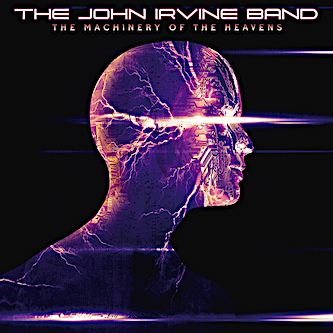 U.K. based guitarist and composer John Irvine continues to redesign the sonic parameters of instrumental jazz-rock fusion. In the spirit of those fusion masters that came before him, John Irvine takes guitar-centric music to the outer limits of the new fusion frontier on his 2020 album The Machinery Of The Heavens. Acclaimed for his relatively recent releases, including Next Stop (2015) and Metaphysical Attractions (2019), the 2020 release of The Machinery Of The Heavens pulls out all the stops on an album that is sure to ignite and delight the musical imaginations of fusion fans and all fans of the electric guitar. With John supplying the guitars, keyboards and bass, the drums and co-production is covered thanks to the gifted Rich Kass, who also backed up John on Metaphysical Attractions. Discussing The Machinery Of The Heavens, John tells mwe3.com “I think it’s my best album so far, with a bit more prog influence on some tracks. Rich Kass has also done a great job on the drums. With “the lockdown” giving me a lot of spare time, I have managed to get three albums worth of material completely finished. I’m delighted but of course it has put me at a point where I don’t have any urgency to write more, I’m so ahead of schedule now… a good place to be, I guess.” Dedicated to the late great keyboardist and fusion pioneer Lyle Mays, The Machinery Of The Heavens takes the art of instrumental jazz-rock music to the next level of sonic greatness.
U.K. based guitarist and composer John Irvine continues to redesign the sonic parameters of instrumental jazz-rock fusion. In the spirit of those fusion masters that came before him, John Irvine takes guitar-centric music to the outer limits of the new fusion frontier on his 2020 album The Machinery Of The Heavens. Acclaimed for his relatively recent releases, including Next Stop (2015) and Metaphysical Attractions (2019), the 2020 release of The Machinery Of The Heavens pulls out all the stops on an album that is sure to ignite and delight the musical imaginations of fusion fans and all fans of the electric guitar. With John supplying the guitars, keyboards and bass, the drums and co-production is covered thanks to the gifted Rich Kass, who also backed up John on Metaphysical Attractions. Discussing The Machinery Of The Heavens, John tells mwe3.com “I think it’s my best album so far, with a bit more prog influence on some tracks. Rich Kass has also done a great job on the drums. With “the lockdown” giving me a lot of spare time, I have managed to get three albums worth of material completely finished. I’m delighted but of course it has put me at a point where I don’t have any urgency to write more, I’m so ahead of schedule now… a good place to be, I guess.” Dedicated to the late great keyboardist and fusion pioneer Lyle Mays, The Machinery Of The Heavens takes the art of instrumental jazz-rock music to the next level of sonic greatness. 